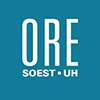To subscribe to the ORE seminar mailing list, click here.
For a (working draft) list of upcoming seminars, click here.
If you are interested in giving an ORE seminar, please contact us at nosal [at] hawaii [dot] edu.
Student Defenses
MS Plan A Defense: A Comparative Study of the Tsunamis from the 2021 and 2023 Loyalty Islands Mw 7.7 Thrust-Fault and Normal-Fault Earthquakes
POST 723 1680 East-West Road, Honolulu, HI, United StatesWilliam Robert Master’s Student Department of Ocean and Resources Engineering University of Hawai’i at Mānoa **This defense will be held both in person (POST 723) and over Zoom** Meeting ID: 940 0074 6297 Passcode: WillMS https://hawaii.zoom.us/j/94000746297 The Vanuatu Subduction Zone is an active tectonic region with a history of moderate to large tsunamigenic earthquakes. While over 40 earthquakes of Mw 7.0 or stronger have occurred along the New Hebrides trench within the past quarter-century, the subduction dynamics, tsunamigenic potential, and coastal risk of tsunamigenic earthquakes emanating from the southern trench remain understudied. We compare the tsunami signals from the 2021
MS Plan A Defense: Nonhydrostatic XBeach Simulation of Wave Transformations in a Fringing Reef Environment: Validation using Field Observations
POST 723 1680 East-West Road, Honolulu, HI, United StatesCharlotte White Master’s Student Department of Ocean and Resources Engineering University of Hawai’i at Mānoa **This defense will be held both in person (POST 723) and over Zoom** Meeting ID: 924 2221 6911 Passcode: CharMS https://hawaii.zoom.us/j/92422216911 Modeling wave transformations in nearshore fringing reef environments is a highly evolving field, especially for engineering applications. This study focuses on wave transformation at Waimānalo Beach, a location that features a shallow fringing reef and sloping seafloor. To study the wave characteristics at the site, the nonhydrostatic version of XBeach (nonhXB), a two-dimension, depth-integrated numerical model is implemented. The offshore boundary wave conditions are
